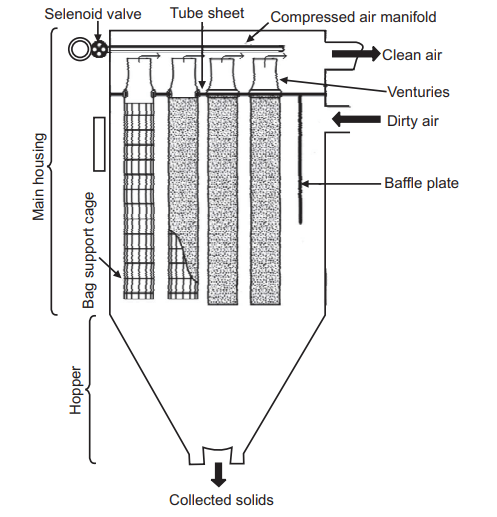The bag filter is a mechanical device used in quality of air in pharmaceutical production and other allied areas. In pharmaceutical production very potent drugs such as hormones, vitamins, antibiotics, etc generates lot of dust during processing which may be life threatening to the operators. These processes include screening, blending, mixing, drying, granulating, tableting, compression, packaging etc. It causes air pollution and chemical hazards. In order to avoid these unwanted situations the air is needed to be maintained clean. This is achieved by use of filter bags. A fabric filter is a dust collection device made using a woven or non-woven filter bag that filters and collects the dust in process gas. When the filter cloth is made into a cylindrical-shaped bag and suspended, it is referred to as a bag house or a fabric filter.
Table of Contents
Principle of bag filter
The purpose of filter bag to collect dust is based upon the principle of filtration. The dust layer adheres to and is deposited on the surface of the filter bag and the interior of the filter cloth (the primary dust layer) filters and collects the dust contained in the process gas. The fabric provides surface for dust particles to get accumulated. The accumulation or collection takes place by inertial or electrostatic interaction, interception and Brownian movement. Together these mechanism results in formation of the dust cake on fabric surface.
Construction of bag filter
This equipment consists of a big metal vessel (bag house) with series of fabric bags in compartments, Fig. 3.7. The bags are made-up of woven cotton, wool, membranes, sintered metal fibers or ceramic cartridges. The selection is based upon the operating temperature and pressure and stability of filter medium to these conditions. Filter bags are suspended in invert position in the vessel. The length of bags varies from 2 to 10 m with a diameter up to 40 cm. The open ends of the bags are attached to the manifold. The number of bags in a vessel varies from 100 to 1000 or more depending on bag house. In the bottom portion hopper is provided to collect dust held by the filter
Working of bag filter
The processing gas enters the system through the intake pipe, which collides with the baffle plate. Large particles slide down due to gravity in the bottom hopper as a result of this impact. The carrier gas then travels upward and out through the bags, leaving fine particulate debris on the inner surface. Normally, the process gas moving through a filter cloth has a filtration velocity of 0.3-2 m/min and a pressure loss of 1-2 kPa. As the dust layer on the filter cloth’s surface thickens, the filter cloth’s pressure loss increases, and the collected dust is intermittently removed. Mechanical shaking, reverse pressure, or a pulse jet are used to remove the dust coating. Fabric filters have a dust collecting efficiency of 99 percent or greater in most circumstances, and the dust concentration at the outlet is less than 10 mg/m3.To achieve better efficiency filter bags are cleaned, maintained and changed intermittently.

Merits
- Filter bag is best method amongst all for removing fines from the air.
- Electricity consumption is low.
- It help to maintain and protect healthy environment.
- They are simple in construction and operation.
- It has versatility and effective design.
- It help to reduce housekeeping and better product quality.
- Filter bags has effective design according to American Ventilation System Standards
- High quality filter bags has trouble free operation.
- It has robust construction.
Demerits
- It has limitations for its operation due to high gas temperature and high humidity.
- The maintenance cost is high as fabric used is costly.
- The characteristics of fabric change with operating parameters.
- Comparatively it is large in size.
- Condensation of vapours and presence of hygroscopic material reduces its efficiency.
Applications of bag filter
- Bag filters are used in industries to separate dust particles from the air.
- These are used to clean the air in working areas.
- They are extensively used in large industries that produce different kind of dust such as metals, cement, chalk and lime, ceramics, flour and foundries.
- It is most commonly used in fluidized bed dryer.